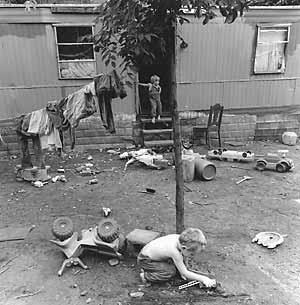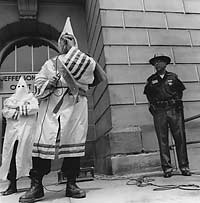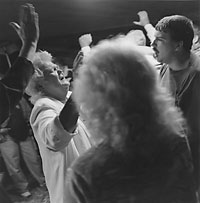|

|

|
NEWS
SEARCH
|
|
|
|

|
| |

|
|
James
(front) and JR at their Thacker Hollow home in West Virginia's
coal country. (Photo © Ken Light)
|
Dying
coal industry, culture are focus of documentary project by UC
Berkeley photojournalist
9 August 2002
By Kathleen Maclay, Media Relations
Berkeley — While millions watched TV reports
of the recent rescue of nine miners in Pennsylvania, documentary
photographer Ken Light was just a state away, quietly photographing
the death of the coal industry and culture.
Each summer for the past three years, Light has packed his
camera gear and headed to West Virginia, the country’s
most impoverished state and a central location in the saga of
the nation’s shrinking coal business.
"Without coal, our world would die, and yet it’s
a completely hidden world, a fascinating place and an amazing
story," said Light, a lecturer at University of California,
Berkeley's Graduate School of Journalism and curator of its
Center for Photography.
He has shot hundreds of rolls of film, making photographs of
West Virginia’s struggling mining communities and the remnants
of former coal company towns, visual records of "what’s
there, what happened and what’s left."
The pictures aren’t pretty.
| |

A
Ku Klux Klan rally outside the Jefferson County Court House.
(Photo © Ken Light)
|
The state where the first discovery of bituminous coal in the
United States was made, and where coal has been found in 50
of 52 counties, is blighted by extreme poverty, welfare families,
black lung and other disease, and a sense of hopelessness about
lost jobs and lost heritage, Light said.
In his visits, as he has tried to trace the roots of "coal
families", he has been invited into homes with retired
miners and their families, attended church tent revival meetings
held outdoors, watched wandering wrestling matches, and recorded
devastating summer floods.
He met a revival "snake charmer" with arms crippled
by almost 160 rattler bites, and was invited into "the
hollows" with a young man who leaned against his truck
to shoot OxyContin, a powerful prescription drug known as "hillbilly
heroin." He has attended a Ku Klux Klan meeting. The homes
of many families, Light said, are no longer traditional wood-framed
structures built on a lot, but trailer homes that can be pulled
from place to place. "The physical house as we know it
is gone," he said.
Although more coal than ever is being removed from the Earth,
fewer and fewer miners have been required in the retrieval of
coal since the introduction of mechanized equipment around 1950.
What once took 100 men now takes one man and a machine, Light
said.

A
"holy roller" tent revival meeting. (Photo ©
Ken Light)
|
|
The work of a coal miner has always been physically demanding
and often debilitating. Yet for generation after generation,
young men have followed their fathers into the mines. Now the
coal industry is a shadow of its former brawny self.
"It’s like cotton in the South. It’s been totally
mechanized and it hasn’t been replaced, there’s nothing,"
Light said. "So you have a culture that’s lost, there’s
kind of a longing for that."
California’s energy crisis and George W. Bush’s presidential
campaign comments about a coal comeback buoyed hopes in West
Virginia, Light said. But mining company executives were more
interested in importing "guest workers" from the former
Soviet Union, Peru and China than in hiring locals at union
wages. Meanwhile, the energy crisis on the West Coast was averted
and West Virginia’s coal industry continues to deteriorate,
Light said.
When Light is done with his photography in coal country, he
plans to assemble an exhibit of his work and publish the photos
in a book, along with personal stories written by his wife,
Melanie.
He is author of five monographs, including "Texas Death
Row," "Delta Time" and "To the Promised
Land." His latest book, "Witness In Our Time," featured
22 interviews of photographers working in this genre. His work
has appeared in Granta, Time, Newsweek, Fortune, Mother Jones,
The National Journal, Speak, L'Internazionale, Camera Arts and
other magazines.
|

|